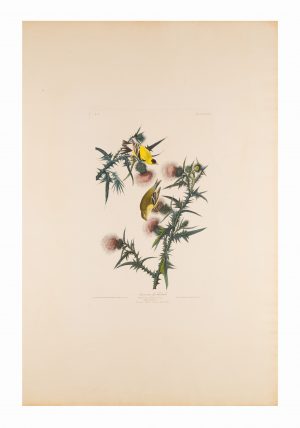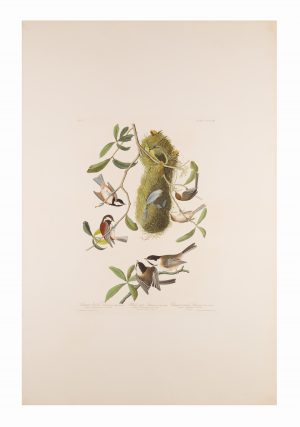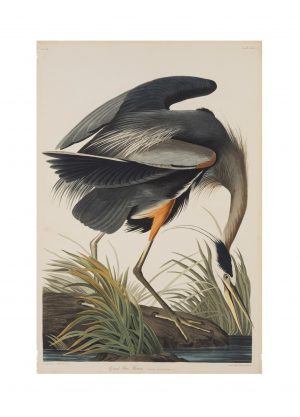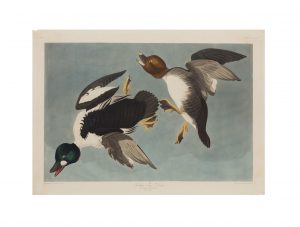By Gabrielle Friesen, Digital Collections Assistant
“Reframing Birds of America:” Conversations on Audubon is now on view at the Colorado Springs Fine Arts Center at Colorado College, located in the Dickinson gallery from April 8th, 2022, to July 30th, 2022. This exhibition features some of the works of John J. Audubon and explores the impact of the practices of 19th century naturalists. “Reframing Birds of America:” is curated by Colorado College students in Rebecca Tucker’s Museum Practicum class.
John J. Audubon was born in Haiti, at the time Saint-Domingue, in 1785. He spent most of his youth in his father’s native France, before being sent to manage his father’s estate in Pennsylvania in 1803 to avoid fighting in the Napoleonic Wars. As manager of the Mill Grove estate, Audubon found himself drawn to the birds of the area and began to document his observations. Audubon used and posed dead birds as references to capture musculature and movement and drew on field observations to try and depict the birds as naturally as possible in his watercolor paintings, although some of his contemporaries criticized his work for having exaggerated movement. His bird illustrations led to the publishing of Birds of America between 1827 and 1838, containing 435 watercolor prints of North American birds. The engraving and coloration of the prints was undertaken in England by Robert Havell Sr. and Robert Havell Jr. Audubon left behind extensive documentation of birds and their behavior in his notes and ornithological art.
Come enjoy “Reframing Birds of America” in person and check out our eMuseum to see our entire selection from Birds of America. While visiting the museum, keep an eye out for birds from Audubon’s work on the FAC grounds and around Colorado College’s campus, as well as in Monument Valley Park and along Monument Creek to the west of us. Several of the birds featured in “Reframing Birds of America” as well as on eMuseum can be seen in Colorado; here is a list of the top five birds from the Audubon collection that you might see in the area while visiting the FAC
5. American Goldfinch

“American Goldfinch,” John J. Audubon, artist, and Robert Havell Jr., engraver, printer, colorist, Collection of the Colorado Springs Fine Arts Center at Colorado College, Gift of the Estate of Phillip B. Stewart, FA 1958.6.20. On view on eMuseum.
A bright flash of yellow zipping between tree and bush means you may have just spotted an American Goldfinch. Following their autumn molt, American Goldfinches are a brown color in winter, with just hints of yellow around the head. After their spring molt, the birds take on their golden color, which is how Audubon chose to depict the birds in this print. The males become a bright yellow except for the black on their wings, tail, and top of the head. Females, though taking on less overall yellow coloration, still sport a lovely yellow front, and take on a yellowish hue to the rest of their brown feathers. The American Goldfinch stays with us in Colorado year-round. You can spot them in the trees around the FAC and the rest of the Colorado College campus, so long as there are some spots for them to sit and tasty seeds to eat.
4. Black-capped Chickadee

“Chestnut-backed Titmouse, Black-capt Titmouse, Chestnut-crowned Titmouse,” John J. Audubon, artist, and Robert Havell Jr., engraver, printer, colorist, Collection of the Colorado Springs Fine Arts Center at Colorado College, Gift of the Estate of Phillip B. Stewart, FA 1958.6.146. On view on eMuseum.
Little birds are an utter joy, and one of the most joyous among them is the Chickadee. Audubon’s original print calls it the “Black Capt Titmouse,” although we know this bird as the Black-capped Chickadee today. While a fast, flitting bird, the chickadee has two unique calls that can offer a clue to what sort of bird you’ve spotted, if you’re without the aid of binoculars, or only caught a passing glimpse. Chickadees tell you their name, with a call of chicka–dee-dee-dee. A second call can be identified with the mnemonic device of “cheeseburger” – a call with two stresses that can sound a bit like the bird is asking for a sandwich. Like the American Goldfinch, Black-capped Chickadees are Colorado residents all year round and can be seen in the junipers and pinyon pines out front of the FAC, as well as the trees in both Colorado College’s broader campus and in Monument Creek.
3. Great Blue Heron

“Great Blue Heron,” John J. Audubon, artist, and Robert Havell Jr., engraver, printer, colorist, Collection of the Colorado Springs Fine Arts Center at Colorado College, Gift of the Estate of Phillip B. Stewart, FA 1958.6.94. On view in “Stories in Flight” at the FAC, and on eMuseum.
The third bird on this list brings us to a series of birds best searched for near the waters just to the west of the Fine Arts Center. The Great Blue Heron can be found wading or patiently standing along river or lake banks as they wait for prey to swim by. While hunting, they extend their long, stately necks with rapid movements to catch fish or other prey, an action depicted in the Audubon print. With their grey-blue coloration, they can sometimes be hard to spot against the reflection of the waters they use as their hunting grounds. Keep your eye out around Monument Creek or the park pond to see if you can spot one against the waterside plants. The flash of the white head feathers that frame their black eye stripe may also key you in to the presence of a Great Blue Heron as they dart their head forward to dip their bill beneath the water in search of a snack.
2. Common Goldeneye

“Golden-Eye Duck,” John J. Audubon, artist, and Robert Havell Jr., engraver, printer, colorist, Collection of the Colorado Springs Fine Arts Center at Colorado College, Gift of the Estate of Phillip B. Stewart, FA 1958.6.140. On view in “Stories in Flight” at the FAC, and on eMuseum.
Unlike the year-round Black-capped Chickadee or American Goldfinch, this bird will require some timing to spot. Common Goldeneyes can be spotted near bodies of water in Colorado in winter and early spring, with occasional off-season sightings. Their bright yellow eyes give them their name and are quite striking even from a distance. The head-feathers on the male are a shimmering green-black, while the females have a warm brown coloration on their heads. This distinction can be seen in the Audubon print, as well as a small bit of yellow coloration on the tip of the female’s bill. This spot of yellow color on the end of the bill can be a helpful indicator when trying to identify female Common Goldeneyes.
See if you can spot the odd Common Goldeneye down in the waters of Monument Creek or the pond in Monument Valley Park, mixed in with groups of the final bird on this list.
1. Mallard

“Mallard Duck,” John J. Audubon, artist, and Robert Havell Jr., engraver, printer, colorist, Collection of the Colorado Springs Fine Arts Center at Colorado College, Gift of the Estate of Phillip B. Stewart, FA 1958.6.96. On view on eMuseum.
Some may say the Mallard duck is too commonplace, too ubiquitous across water features in the United States to be an exciting bird spotting. Not I! The Mallard is a steadfast friend. Even if all other birds are absent – the Chickadee chased away by an elusive bird of prey, the American Goldfinch off to fuller feeders, the Common Goldeneye gone until next winter – you can always count on a Mallard duck spotting in Monument Valley Park. Whether chilling along the banks of Monument Creek or paddling around the pond, a Mallard duck is almost always present for you to gaze upon.
On top of that stalwart presence, they are beautiful. The deep greens of the Mallard’s head glimmer in the sun, while the females have a lovely bit of blue along the wing, hidden amidst the patterns of their brown feathers. The Audubon print depicts this coloration, as well as some of the lively character that can be observed in the movement and activity of the Mallard duck.
After visiting the Fine Arts Center and seeing “Reframing Birds of America:” Conversations on Audubon or after having looked through “A Selection from John J. Audubon’s Birds of America” on our eMuseum, you may find yourself in the mood for bird watching. If so, keep an eye on the trees around the FAC and the greater Colorado College campus, or head down the slope towards Monument Valley Park, and see which birds you can spot.
Happy birdwatching, and happy art viewing!

